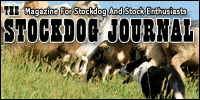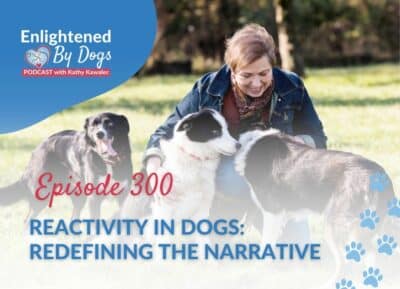
How to have a good working partnership with your stockdog.
When your herding dog doesn’t listen, it’s a call for help, not a reason for a correction. That’s when a partnership based on trust and clear dialog changes everything.
Remember the last time your dog ‘got distracted’, ‘blew you off’, or just ‘didn’t listen’?
- Was that last week when your dog wouldn’t stop and you nearly got run over at the gate?
- Remember that last training session when your young dog was racing around the sheep in ever tightening circles as you tried desperately to make him get further off?
- Aren’t you still smarting with embarrassment from that trial where your dog chased sheep down the field?
These training challenges and others just like them are the source of frustration for so many of us. We think we’re doing a good job training and handling our dogs, and yet we are still experiencing these problems. Maybe just once in a while, or maybe a lot.
So we train harder, train more often. Still, the same problems crop up and we get frustrated as we try different things that just don’t work or don’t stick.
When we can’t ‘train away’ the problem, we might ultimately conclude that our dog ‘has her own agenda’.
And, I completely agree with you. But not for the reason you think. After 35+ years of training and showing horses and dogs, I’ve discovered that our dogs DO have their own agenda, and here it is:
Dogs THRIVE when they are a contributing member of well functioning partnership.
Dogs are social beings, like humans. We have a lot in common, and that’s one of the main reasons we get along so well. Dogs LOVE to please us, in the same way we love to please people (and animals) that we care about. Like us, dogs SEEK harmony, companionship, and a way to contribute to the overall well-being of their family group. THAT’S their agenda.
The reason that you are having these training, working and competition issues is that your dog does not understand what you want, in the context of collaborating with you to get the job done. They are confused or conflicted. Or both.
Here’s how I think about this in terms of a working partnership with dogs:
Every time your dog ‘makes a mistake’ or ‘blows you off’ or ‘gets distracted’ or ‘doesn’t listen’: It’s FEEDBACK. Plain and simple.
Your dog is communicating to you. She’s saying: “I don’t get it.” Or: “This is really hard, maybe too hard.”
Maybe he’s saying: “Could you please be more clear?” Or: “I could really use some help with this!” Or: “Are you SURE that’s what you want, because that feels wrong to me.”
Your dog is NOT saying: “Screw you. Get out of my way so I can do what I want.” If you have thought this about your dog…stop reading for a few moments, open your mind, and re-imagine the scenario from this new perspective.
OK. See what I mean?
Here’s a perfect Case Study of a confused dog and a frustrated handler.
Recently, a woman and her young border collie were here at the farm for a herding lesson. They are novices, and are making great progress in their herding skills and teamwork. The lesson of the day was to expand their stock skills through learning how to handle three very flighty cheviots by staying calm, focused and carefully reading the sheep as collaborative partners.
The sheep were calmly grazing at the far end of the small field, and the assigned task was to have the dog gather them and to settle the sheep with handler.
The first couple of attempts didn’t go so well because the dog was tense, fast and tight, causing the sheep to run which caused the handler to yell at her dog to get out…which in turn caused the dog to stay tense and tight.
All my student wanted was for her dog to gather the sheep, bring them to her and settle the sheep there in front of her…but instead the sheep just ran from place to place in the field. When the dog did get the sheep near the handler she was harsh and abrupt with trying to get her dog to lie down, which caused the sheep to flee instantly.
Even though we thoroughly discussed in advance what might happen and how she should respond in a helpful way, the handler allowed herself to become quickly frustrated and after those first failed attempts, she threw up her hands, saying angrily that her dog “wasn’t listening and he wasn’t even trying to do it right”.
She then loudly declared to me in frustrated exasperation: “He’s running past balance, over-flanking and he won’t lie down when I tell him.” Whew.
My intention is to teach my students the process for understanding, problem solving and making valid choices…to help them to become great dog trainers and stock handlers...not only to listen to my advice, but to be effective even when I’m not there with them.
So, we stopped the action and discussed the situation.
Here is what we discovered:
- The handler was not closely watching her sheep, she was much more focused on her dog, so she was missing vital details about the sheep.
- She was not doing her part to quietly contain the sheep in front of her when her dog did bring them to her. Instead she was rough in her movements causing the sheep to flee.
- The dog wouldn’t lie down where she wanted, because she was asking him at the worst possible time in the worst possible place.
- That caused her dog to become very tense because he couldn’t do his job properly (gather sheep to his person). The more confused and tense he became, the worse things got.
The solution:
- The handler needed to take a deep breath and relax.
- Then, assess the big picture. The set up was too hard for her dog. How could this be made easier, ensuring success?
- We repositioned the dog at the start to promote a proper flank shape, and the handler moved into a more helpful position, part way between the dog and the sheep.
- We made sure that we sent the dog to gather the sheep in the direction most likely to be successful, so he could more easily cover the sheep, which would help him to relax and do his best outrun.
- The handler was to contain the sheep without pushing them away with rough movements as they approached her. In other words, she should model the exact behavior she wanted her dog to mirror. Calm, mindful, attentive and responsive stock handling.
- And she was to carefully watch the sheep…and her dog for the indicators of balance…not asking her dog to lie down until he was at balance. (fyi: balance means the exact place that controls the sheep in the desired position)
The result:
Perfection! The dog calmly brought the sheep to his favorite woman. She calmly communicated with the sheep, containing them in front of her. The dog lied himself down at balance, she didn’t even have to ask him. It was a beautiful and perfectly executed gather. They then repeated that in several places around the field, and it was perfect every time.
Summary:
This dog was begging for help from his handler. All he had on his agenda was to bring her the sheep like he knows to do. He needed help, not a correction. He needed information, not an accusation.
Is your dog begging for help?
Think of the last time your dog ‘made a mistake’ or ‘blew you off’ or ‘got distracted’ or ‘didn’t listen’. Then follow the steps in my Formula for Herding Training Success before you step through that gate with your dog again. This formula applies to any type of dog, any type of stock, any level of expertise.
Kathy’s Formula for Herding Training Success
- Assess the big picture — what exactly is the lesson, task, goal of this work session/trial run/training session?
- What feedback is your dog giving you, precisely? You’re looking for your dog’s perspective here…so that you can be the leading partner your dog truly needs.
- How can you set up the work easier or more clearly, ensuring success for you, your dog, your stock? How can you break this down into ‘baby steps’ for maximum clarity?
- What information does your dog need from you, moment by moment during the work, in order to be successful?
- Get More Clarity. Sometimes it’s hard to understand the interaction with our dog when we are in the middle of the action. You might need another set of eyes to help. A video camera is perfect! You can review later, and so can your coach. Make a new plan.
- Then go ahead and try again. Make adjustments as needed…you may need to go through the steps several times until you become fluent in the process.








5 Responses
This is SO US!!!! Both of my dogs……border collie mistakes/ distraction and doxie blow off/no listen AND me throwing accusations and not giving information as needed. Need baby steps. Can see it now after reading this…..thank you!
So glad this helped Deb! 🙂
Hi Kathy,
I love this. I often think, “She just blew me off” as it’s happening. But in my head I know she loves me and really WANTS to be good. I also feel like we’re working too far ahead of our level (both of us.)
I like the steps. I’ll take them to class with me.
Thank you!
It’s easy to do George…we’re culturally conditioned to that perspective. Better to look for solutions…and take baby steps to ensure success!
I find that your observations are right on point. They apply of course to all phases of dog training. I have found myself in almost the same situation as your ca see study. The more frustrated I got the more out of control my dog was. I had to stop, break the task down into small pieces and calmly carry on. And it worked !!!!!